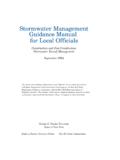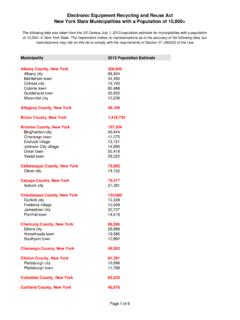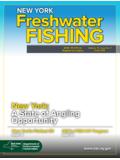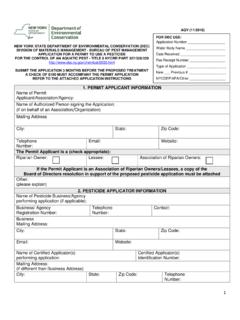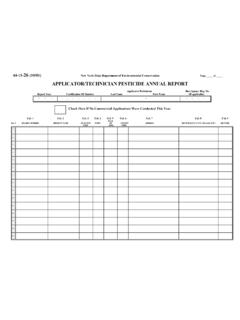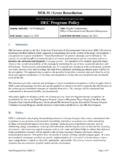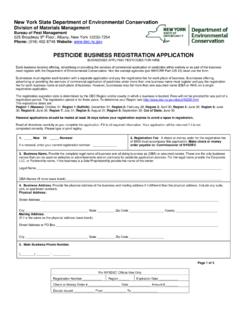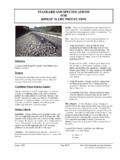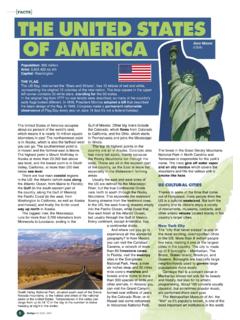Transcription of An Introduction to Responsible Trapping
1 Trapping Furbearers An Introduction to Responsible Trapping Student Manual i Code of Trapping Ethics 1. Know and obey Trapping laws and assist in their enforcement by reporting violations. 2. Improve your knowledge of furbearers, their ecology and management, and improved Trapping and fur handling methods. 3. Respect landowners rights and always obtain permission before Trapping on private lands. 4. Respect and conserve public lands and the natural resources found on them. 5. Be aware of other people using the outdoors and avoid interference with their activities.
2 6. Be aware of free ranging domestic animals and avoid Trapping where there is a high risk of catching them. 7. Know and use selective and humane Trapping sets with appropriate trap types and sizes. 8. Don t set more traps than YOU can effectively handle. 9. Cover all foothold traps set on land. 10. When Trapping muskrat, always use body gripping traps, guarded foothold traps, or submersion sets. 11. Use body gripping traps or submersion sets with sliding locks for all beaver and otter sets. 12. Anchor traps securely enough to hold the largest potential catch.
3 13. Check all traps daily and as early in the day as possible. 14. Dispose of animal carcasses properly. 15. Support Trapping , trapper training, and furbearer management and research. 16. Report diseased animals. 17. Make an effort to trap any areas where furbearer populations are overabundant or are creating a nuisance. 18. Know and use proper releasing and killing methods. ii Trapping Furbearers An Introduction to Responsible Trapping Acknowledgements A long list of distinguished individuals had a hand in the development of this manual over time. It is based in part on, Trapping Furbearers Managing and Using a Renewable Natural Resource , by Dr.
4 Ronald Howard and Dr. John Kelley, published by 4 H/Cooperative Extension at Cornell University. Former and current Department of Environmental Conservation (DEC) staff who participated in the manual s many editions include Louis Berchielli, Gary Parsons, Mark Brown, Wayne Jones, Paul Bishop, Benjamin Tullar, Robert Henke, David Scudder, Gordon Batcheller, Scott Smith, Melissa Neely, and Ken Baginski. Critical review of the text was provided by trappers Pete Smith, Tom Hayes, Angie Leubner, Pete Rickard, Gordon Berndt, Tom Fisher, and Ray Schedivy (1st edition), Al West and Jerry Leggieri (2nd edition), and John Rockwood, Angie Berchielli, and Jerry Leggieri (3rd edition).
5 Fourth edition, printed in 2016. DEC biologist Andy MacDuff performed editorial duties with input from trappers Lou and Angie Berchielli. Materials used from other sources for this manual include: Association of Fish & Wildlife Agencies logos on page 33 and material in Chapters 5, 7, and 8 and Appendices 1, 2, and 5 (with changes) Silvertip Productions Images on pages 5, 6, 15, 16, 17, 80, 81 (bottom), 100, and 101 Ohio Division of Wildlife Images on pages 24 (top), 26 (bottom), 30, 37, 39, 77, 78, 81 (top), and 86 through 93 Joe Goodman Images on pages 26(top and middle), 29 (bottom), 75 (all but weasel box), 104, and 105.
6 Animal artwork was provided by Wayne Trimm and all other drawings by Michael Stickney. Funded in part by Federal Aid in Wildlife Restoration Act, project W 125 S, a hunter education project supported by federal excise taxes on hunting equipment. Copyright 1997, 2006, 2011, 2016. All rights reserved. Material may not be reproduced in any manner without express written permission from the Department of Environmental Conservation. NYSDEC Sportsman Education, 625 Broadway, Albany, NY 12233 4800iii Trapping Furbearers An Introduction to Responsible Trapping Table of Contents Chapter 1 Introduction .
7 1 Chapter 2 History of Trapping .. 3 Chapter 3 Furbearer Management .. 5 Chapter 4 Trapping Laws, Regulations, and Ethics .. 9 Chapter 5 Trapping Safety and Wildlife Diseases .. 15 Chapter 6 Equipment and Preparation .. 23 Chapter 7 Best Management Practices .. 33 Chapter 8 Selective Trapping Techniques .. 37 Chapter 9 Natural History of New York Furbearers .. 41 Chapter 10 Common Water Sets .. 67 Chapter 11 Land Sets .. 74 Chapter 12 Running a Trapline .. 80 Chapter 13 Fur Handling Equipment, Techniques, and Marketing .. 86 Appendix 1 Traps, Sets, & Attractors.
8 98 Appendix 2 Tracks of New York Furbearers .. 100 Appendix 3 Scats of New York Furbearers .. 102 Appendix 4 Regulations for Body Grip Traps Set on Land .. 104 Appendix 5 Pelt Preparation .. 106 iv 1 Chapter 1 Introduction You and Trapper Education Trapping is enjoyable and it provides a variety of benefits to those with the knowledge and ability to do it well. But, if Trapping is not done right, it can cause bad feelings towards trappers and Trapping . Therefore, Trapping is a serious business. The future of Trapping depends on the way you as a trapper perform.
9 Successful completion of a trapper education course is required of all first time trappers in New York State. This requirement started in 1980 to increase awareness of the trapper s responsibilities and to introduce beginning trappers to acceptable Trapping methods, ethics and responsibilities, laws and regulations, natural history, and basic wildlife management principles. All of these things provide a good start for new trappers. Trapping skill, however, must be developed through experience after the course. The things you learn in this course will help make Trapping more enjoyable and help make you more successful.
10 Through this course, you can learn more about the tradition and adventure of Trapping , increase your environmental awareness, gain new outdoor skills, and maybe even make some money. In addition, there is the opportunity for personal development through hard work, careful study, and a better understanding of nature and wildlife. It is hoped the course will also encourage beginning trappers to learn more about Trapping from personal experience and the experience of others. You can learn even more about Trapping from information you can get from your instructor, your library, the internet, and from local, state, and national trapper organizations.
